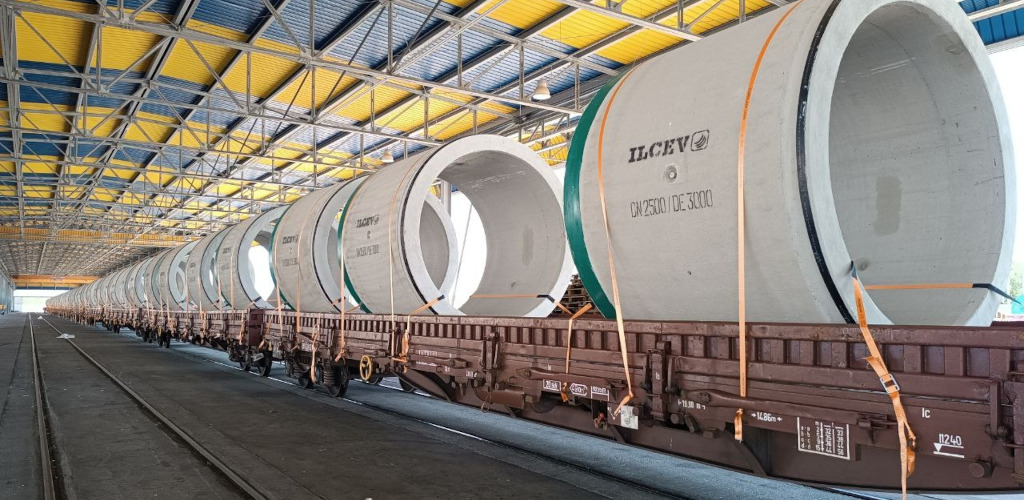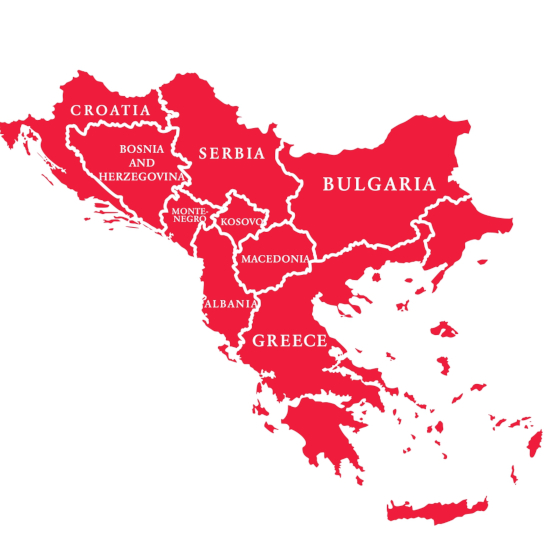Renewable Energy Boom Spells Opportunity for Breakbulk

By Emma Dailey
As billions of euros flow into the Balkans to upgrade transport networks, construct wind farms and build solar plants, the demand for specialized logistics services is soaring. Balkans-based project professionals weigh the project landscape.
From Issue 4, 2024 of Breakbulk Magazine.
(7-minute read)
Amid the ongoing war in Ukraine, the European Union (EU) is bolstering its ties with the Balkan countries, many of which are currently outside the bloc, by funding significant infrastructure and energy initiatives. A growing trend in the region is investment in renewable energy projects, including wind, solar and biogas - all of which mean business for local project forwarders.
The Ukraine war is another factor that has significantly impacted the logistics, project cargo and breakbulk industries in the Balkans over the last two years. Military convoys are “straining the transport infrastructure in Romania,” says Adrian Slavu, project manager at Modpack. In Bulgaria, military exercises have increased military machinery movement leading to “extra costs” and “big delays,” notes Mladen Ganchev, manager of Holleman Bulgaria.
Sanctions against Russia further complicate the situation, affecting the volume of goods transported. Transit volumes through Bulgaria, particularly to Kazakhstan, increased last year but are now decreasing. “These will directly depend on the sanctions against Russia and the need to find new routes,” Ganchev says.
Changes in cargo types are also evident. “We are now dealing with a large volume of grains,” attests Karolina Cigula Božičević, managing director of Samer International. Meanwhile, the Bulgarian agricultural sector has suffered due to decreased wheat prices and export volumes, and higher costs for last year’s crop. This downturn has reduced the sale of agricultural machinery - “another blow to the transport companies in the region,” adds Ganchev, who foresees another significant drop in this area in 2024.
An end to the conflict remains a distant prospect at the present time, however geopolitical concerns have highlighted the strategic importance of bringing the Balkans closer to the EU. “The Balkans and Romania (already an EU member) have the potential to emerge stronger through increased regional cooperation and integration with Europe,” Slavu says.
 An Ever-Closer Union
An Ever-Closer Union
After a period of enlargement fatigue, the conflict has renewed EU expansion efforts, reviving the aspirations of several Western Balkan nations to join the bloc (of the nine countries granted EU candidate status, six are Balkan states). Integration with the EU’s single market has historically driven economic growth and increased freedom of movement, benefiting the transport sector.
EU member Croatia joined both the European Economic Area (EEA) and the free movement ”Schengen” area, last year, while fellow members Bulgaria and Romania joined Schengen on March 31, 2024, achieving Bulgaria’s “most important goal,” said Ganchev.
EU accession requires would-be members to satisfy the Copenhagen criteria, which demand stable institutions, democracy and a competitive market economy. Based on historical trends, this involves improving the ease of doing business and clamping down on corruption.
“Transparency in choosing subcontractors and high levels of corruption are well recognized as one of the negative drivers of further development,” says Maja Sudjicki, managing director and partner at Samer & Co. In Romania, “many investors expect the business environment to improve in the coming years as key reforms are implemented,” adds Slavu.
New Growth Plan for the Western Balkans
Recognizing both the geostrategic importance of rapprochement and that the reforms needed for EU accession are costly, the EU Commission aims to facilitate the process in Albania, Bosnia and Herzegovina, Montenegro, North Macedonia, Serbia and Kosovo through the New Growth Plan for the Western Balkans, announced in November 2023.
It aims to bring Western Balkan partners closer to the EU by offering pre-accession benefits and boosting economic growth. Implementation accelerated this spring with regional summits in Albania and Montenegro, addressing topics such as membership of the Single Euro Payments Area, a payment integration initiative which Albania applied to join in June, and customs cooperation.
The New Growth Plan for the Western Balkans is supported by a financial instrument, the Reform and Growth Facility, worth 6 billion euros between 2024 and 2027. “The region should be able to double its economy in the next 10 years,” claimed Olivér Várhelyi, an EU commissioner, at a press conference in March. “It will be very difficult for the region to argue after 2027 that they are not ready to join the EU,” he added.
Sustainable transport and clean energy are receiving the lion’s share of EU investment in the Balkans. The benefits to the project cargo and transportation sectors are twofold: on one hand, demand for special transport will increase for renewable projects, and on the other, improved infrastructure will lead to better conditions in the region.
Balkan Renewable Energy Boom
In 2022, the EU proposed an Energy Support Package for the Western Balkans, where the energy mix is still dominated by coal, to tackle the energy crisis and promote clean energy. The 1.8 billion euros EIP package encompasses 21 flagship projects, with the final 50 million euros to be made available this year upon successful implementation of the action plans in the package.
Balkan EU member states are also bound by EU Green Deal 2030 sustainability goals. Bosnia and Herzegovina targets a 43.6% share of renewables in gross final domestic energy consumption by 2030, while Serbia is aiming for 45.2%.
For Ganchev, “the positive news for the region is the restart of the windmill projects in 2025. There are many surveys running and plenty of inquiries as well. It seems the sector will be busy in the coming years with such transports.”
In Serbia, “As a new trend, many private investors are getting behind renewable energy — wind, solar and biogas projects. The most challenging projects that will come to Serbia in the next few years would be wind parks in the mountains and some 100 sites are already in planning,” says Sudjicki.
Bozicevic adds that Samer International is “engaged in significant discussions in Serbia” surrounding this “logistically very demanding project.” In Croatia, she notes that solar power plants are also planned.
During the Balkan Energy Forum in May, the Greek government announced that public investment will reach 12.2 billion euros for 2024, “the highest ever reached for the last 14 years,” underscores Elisabeth Cosmatos, president of The Heavy Lift Group and CEO of the network’s member for Greece, Cosmatos Group. Greece has approved 20 solar parks with a total capacity of 1,117.14 MW. A hydropower plant is planned in western Greece, along with further development of onshore and offshore wind parks.
Balkan renewable energy projects are thus expected to stimulate the transport industry in the region as states aim for 2030 goals. This uptick in projects will add stress on local infrastructure, presenting new challenges and opportunities.
Infrastructure Challenges and Opportunities
The EU aims to boost transport connections and logistics through infrastructure funding. Through European Innovation Partnerships, the EU has invested 5.2 billion euros in 21 flagship projects. Sudjicki notes increased business opportunities in Serbia due to extensive infrastructure investment.
Bulgarian Defense Minister Todor Tagarev announced plans for Bulgaria and Greece to seek EU funding for a new highway between Thessaloniki, Kavala, Alexandroupolis, Burgas, and Varna in January. Last year, Greece also proposed a new rail corridor connecting Bulgaria, Moldova and Romania with Ukraine, starting with a pilot link between Alexandroupolis, Thessaloniki, Ruse, and Constanta. Increased regional collaboration will play a key role in handling the influx of projects.
This opens new routes and opportunities for Greek ports to serve as hubs for breakbulk services to neighboring countries. “Solar and wind projects in North Macedonia will use Thessaloniki port as a key hub,” Cosmatos says. Thessaloniki, Burgas, and Varna ports are also essential for Bulgaria’s logistics, she notes.
 To address the lack of port space, Greek ports are implementing capacity-expanding measures such as draft deepening in the Ports of Stylis and Volos. Greece’s port management has inaugurated weekly rail services between Thessaloniki and Sofia, Bulgaria, and Niš, Serbia.
To address the lack of port space, Greek ports are implementing capacity-expanding measures such as draft deepening in the Ports of Stylis and Volos. Greece’s port management has inaugurated weekly rail services between Thessaloniki and Sofia, Bulgaria, and Niš, Serbia.
These dry ports, extensions of the Thessaloniki port free zone, offer final delivery to Sofia and Niš. However, “urgent investment in infrastructure, cranes, and cargo-handling equipment” is still needed in Thessaloniki, says Cosmatos. “Due to severe traffic and infrastructure limitations, we are often forced to divert our trains to Koper or Italian ports,” adds Bozicevic.
To cope with such limitations, Bozicevic sees “potential for growth in smaller ports, which could alleviate congestion at Rijeka,” adding that “this decentralization could provide more options for handling cargo and stimulate economic growth in surrounding areas, marking a positive change for the future.”
Despite concerns over supply chain integrity and energy security, the future of project cargo in the Balkans is promising. Regionally, “There are a lot of prospects for project cargo; we are optimistic,” Cosmatos asserts.
Slavu concludes: “Intermodal transport, combining multiple modes such as rail and road, is expected to witness rapid growth. This optimism is fueled by substantial investments in renewable energy and infrastructure projects, creating significant business opportunities for the project cargo and breakbulk sectors.”
Modpack, Holleman Bulgaria and THLG are exhibitors at Breakbulk Europe.
TOP PHOTO: Samer International transports OOG by rail.
SECOND: Elisabeth Cosmatos.
